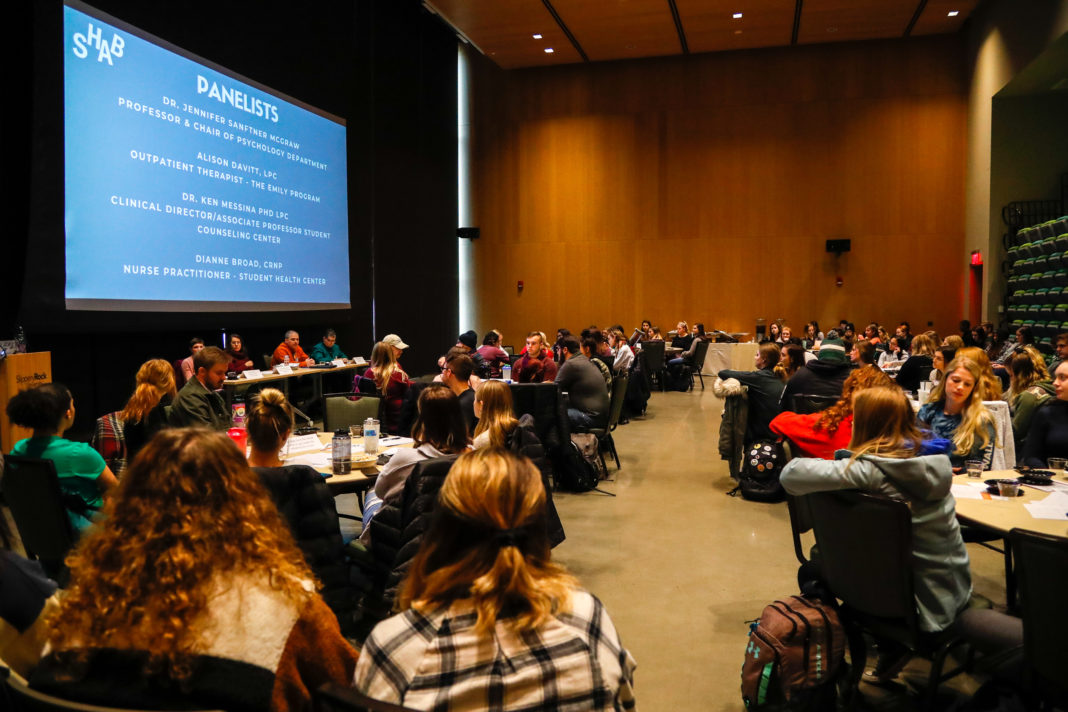Disclaimer: the following story contains mentions of eating disorders and may be triggering to some readers. Please read with caution at your own discretion.
To submit a care report for yourself or someone you are concerned about, click here.
If you or someone you know needs help, local help is available through campus police (724-738-3333), the Health Center (724-738-2052) the Counseling Center (724-738-2034) and student support (724-738-2121). The National Eating Disorder Association helpline is available Monday through Thursday from 9 am to 9 pm and Friday from 9 am to 5 pm (800-931-2237).
The Student Health Advisory Board (SHAB) hosted their second meeting of the semester in the Smith Student Center Theater on Thursday and invited four panelists to discuss eating disorders, common misconceptions and myths and how to identify any warning signs.
Alison Davitt, an outpatient therapist at The Emily Program in Wexford, began the discussion by asking the audience to list any myths they have heard — whether in media or real life — about eating disorders.
“It’s exclusive to only white teenage girls and that males, people of color and older people can’t have an eating disorder,” one audience member said.
Davitt added that a classic myth is that eating disorders only affect privileged white women, but she said that she sees and works with people of all different genders, ages and ethnicities with eating disorders.
“If you have an eating disorder, then you have to be severely underweight,” another audience member said.
Davitt added that she commonly hears the phrase “I’m not sick enough” from people in treatment, which she says isn’t true. She also said we see many people walking around the community who appear to not have any symptoms, but they still might be sick.
“There’s no threshold of sickness a person has to be at in order to seek treatment,” she said. “You don’t have to be underweight or overweight or anything to have an eating disorder.”
Davitt responded to the question herself with one misconception she hears pretty often: eating disorders are a “lifestyle choice.” She continued to adamantly explain that eating disorders are illnesses and that nobody chooses to be sick.
Davitt said another common myth she’s heard is that eating disorders are incurable, that they are chronic illnesses that someone will always have, which isn’t true. She added that she works with people who get better every day and have experienced cures firsthand.
Jennifer Sanftner McGraw, professor and chair of the psychology department and advisor of the Reflections Body Image Program on campus, said many people believe those who struggle with an eating disorder “just need to eat.” She added that eating disorders are about much more than just food and eating.
“They’re about your sense of self, your self-control and how you’re coping with life and the world. With some disorders, your brain is telling you that you need to do this,” McGraw said. “It’s not just a matter of going to eat a meal. These are true disorders that people struggle with, and they can’t control it.”
Dr. Ken Messina, the clinical director of the Student Counseling Center, added that people often go to a family doctor or a counselor who doesn’t have any training or background with eating disorders. He believes that this can actually work against someone in recovery and delay their progress, and that they should seek help from a specialist.
The panel then discussed the warning signs of an eating disorder and how to identify them. McGraw said a red flag is being preoccupied with food or setting rules set for themselves about food. She also added that weight loss can be an indicator of an eating disorder, but that there are several other factors and causes of weight loss. She also said “fat talk,” or frequently asking if you look fat in your clothes, could also be a warning sign.
“People with eating disorders tend to be overly focused on or preoccupied with body image,” McGraw said. “They seem to equate their self-worth with their bodies. They believe their value is tied to their body size and shape.”
Davitt said multiple bathroom trips following meals can be another potential indicator, but that this could also be caused by other different factors. Social withdrawal, she said, could be another warning sign, especially if the social invitation includes food or meals.
“A lot of my clients had their kind of ‘light bulb moment’ when they realized that they’d declined a lot of social invitations, particularly if they involved food,” Davitt said. “The same goes for constant exercise. They turned down invitations to events or things they used to enjoy because they wanted to exercise all the time.”
An audience member posed the question, “When does being conscious about what you eat and working out and overall trying to make healthier choices cross the line to becoming an eating disorder?”
Messina said that anyone struggling with an eating disorder will experience a decreased quality of life. He added that physical, emotional and mental well-being all factor into a person’s quality of life and that having an eating disorder negatively affects all three.
“Whether it be social isolation or fainting due to malnutrition and too much exercise, an eating disorder changes your quality of life for the worse and impairs your ability to function,” Messina said.
Another audience member asked about different treatment options for people who have an eating disorder, and Davitt took the opportunity to shine a light on The Emily Program and their various treatment plans.
The inpatient program is a 24-hour stay at a hospital and is often for clients who have significant medical complications such as low heart-rate, electrolyte imbalance or extreme weight loss. Residential treatment takes place at one of their facilities, which includes around-the-clock care, meals, medical monitoring and a team approach which includes dietitians, psychiatrists, individual and group therapists.
The all-day treatment program is Monday through Friday from 9 a.m.-5 p.m., and the only difference between it and residential treatment is that clients do not stay at the facility. Intensive outpatient treatment is typically three hours a day, three days a week and includes a therapeutic meal followed by group sessions and check-ins. General outpatient treatment is only a once-a-week hour-long meeting to help clients develop recovery skills.
“It’s all very individualized,” Davitt said. “I think that’s another misconception — that people who have eating disorders have to seek residential treatment. Everyone is different and not everyone needs the same level of care.”
Another audience member asked about the focus on restrictive or avoidant eating disorders like anorexia and if it’s because they’re more prevalent than other disorders like bulimia or binge-eating disorder.
Davitt said there isn’t enough emphasis on eating disorders in general, but “low-weight status” clients sometimes get more attention because their underweight appearance can be startling and “a little bit more obvious.” She added that this doesn’t mean other eating disorders don’t exist.
“Binge-eating is often misunderstood,” McGraw said. “Binge-eating is eating a lot of food in a very out-of-control way. One of the common myths is that people with binge-eating disorder just eat too much or emotionally eat, but this isn’t true.”
From the discussion about treatment options arose an audience question about how to appropriately approach someone you’re concerned about.
Messina said the best way to approach someone is to show that you come from a place of caring. He encouraged audience members to tell the person you’re concerned about simply that you’re worried and ask them how they are feeling and what they may need.
“Coming from a place of caring is probably the most important part,” Messina said, “because no matter what, you’re just concerned for that person and want to see them get better.”
McGraw added that using “I” statements is important because you’re telling the person you’re concerned about what you’ve been observing and feeling rather than being unintentionally accusatory.
“People are going to be more defensive if you say things like ‘You’ve been doing this or that’ instead of ‘I’ve noticed this’ or ‘I’m feeling this’,” McGraw said.
The panel — specifically Messina and Dianne Broad, the Student Health Center’s nurse practitioner (CRNP) — also discussed what the counseling and health centers would do to help a student struggling with an eating disorder.
Broad said the staff at the Health Center is focused on the medical aspect. They would ask general questions, including why they came to the Health Center and what they think the issue is. The registered nurse, CRNP or physician would check the student’s blood pressure, compare their current weight to their previously documented weight, listen to and check their heart rate and possibly take blood tests and perform an electrocardiogram (EKG) test.
Messina said that the first step at the Counseling Center is to assess the level of care a student might need. If a student is struggling with a specific eating disorder and needs proper care and treatment, the Counseling Center staff then helps the student find the right services and help they need. They would also, depending on timing, set up bridge sessions with them to help them manage their eating disorder and their symptoms until they can seek the level of treatment they need, whether it be residential or intensive outpatient care.
“Before someone can get into an eating disorder recovery program, they have to be physically stable,” Broad said. “They can’t be in the midst of a heart attack or have severe kidney failure before they actually get into a program. That’s why you have to assess them for medical problems first.”
Before closing the discussion, the panel also talked about eating disorders in athletics. Messina unofficially took the lead on this topic because he works with athletes and was an athlete himself.
Messina said that visually identifying an eating disorder in an athlete can be difficult because it’s not about the stereotypical drive for weight loss and thinness. Most often, athletes strive for more muscle tone and being more “cut.”
“When you have an eating disorder or body image issues, it distorts how you see yourself. No matter how thin, in shape or muscular you are, you’ll never reach the ideal you’ve formed in your head,” Messina said. “There’s a lot more pressure, I think, on athletes to meet that specific body image that we don’t normally see in the rest of the population.”
McGraw added that it can be difficult to know when an athlete is focusing on being the best in their respective sport and when their focus shifts to disordered eating behaviors and thought patterns. Athletes also exercise a lot more often than the average person; they sometimes work out as many hours in two or three days as some people do in an entire week.
“What is excessive exercise for an athlete?” McGraw said. “It’s not always just the number of hours that a person exercises. You need to factor in the underlying reasons. Are they pushing themselves beyond their coach’s recommendations? Are they working out through injury when they shouldn’t? Are they tying their self-worth into their exercise regimen?”
Messina said one of the biggest sports with disordered eating behaviors in athletes, the sport he participated in, is wrestling. There is a large focus on weight in the sport because of the weight requirements. He said he worked a lot with high school and college wrestlers because their focus on their weight and body image became very disordered.
“I stepped on the scale every single day. I weighed every bit of food before I ate it. I ran constantly, beyond practice,” Messina said. “Reaching the weight requirement became a kind of obsession.”
Davitt said she works with a lot of high school swimmers and often finds that they come in with very low heart rates. She said, in these cases, doctors don’t often look further into the causes of their lowered heart rates and often dismiss it because they’re athletes. She added that another symptom she sees is the lack of a period in female athletes.
“I think they have this kind of mentality that excuses the loss of a period because they’re a runner or they work out a lot,” Davitt said. “In reality, it’s a sign that your body is in distress, and that needs to be checked out.”
McGraw added that coaches need to be much more educated about eating disorders for the well-being of the teams they supervise.
“In my experiences, many coaches are not well-versed in eating disorders and not looking for symptoms. Coaches sometimes even encourage dangerous behaviors and push them toward an eating disorder,” McGraw said. “You can’t always assume that a coach is necessarily doing things that will help their athletes.”








